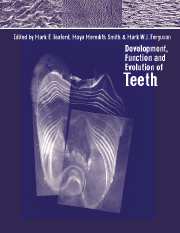Book contents
- Frontmatter
- Contents
- List of contributors
- Acknowledgements
- Part one Genes, molecules and tooth initiation
- Part two Tooth tissues: development and evolution
- Part three Evolution of tooth shape and dentition
- Part four Macrostructure and function
- 16 Developmental plasticity in the dentition of a heterodont polyphyodont fish species
- 17 Enamel microporosity and its functional implications
- 18 Pathways to functional differentiation in mammalian enamel
- 19 Trends in the evolution of molar crown types in ungulate mammals: evidence from the northern hemisphere
- 20 Function of postcanine tooth crown shape in mammals
- 21 Primate dental functional morphology revisited
- Index
16 - Developmental plasticity in the dentition of a heterodont polyphyodont fish species
Published online by Cambridge University Press: 11 September 2009
- Frontmatter
- Contents
- List of contributors
- Acknowledgements
- Part one Genes, molecules and tooth initiation
- Part two Tooth tissues: development and evolution
- Part three Evolution of tooth shape and dentition
- Part four Macrostructure and function
- 16 Developmental plasticity in the dentition of a heterodont polyphyodont fish species
- 17 Enamel microporosity and its functional implications
- 18 Pathways to functional differentiation in mammalian enamel
- 19 Trends in the evolution of molar crown types in ungulate mammals: evidence from the northern hemisphere
- 20 Function of postcanine tooth crown shape in mammals
- 21 Primate dental functional morphology revisited
- Index
Summary
Introduction
The dentition has long been, and still is, important to vertebrate biologists: to palaeontologists, because teeth often represent the sole fossil evidence available; to taxonomists, because of the estimated high taxonomic value of teeth; and to developmental biologists, because teeth provide an excellent experimental model to test developmental principles. Yet, relatively little attention has been paid in these various disciplines to intraspecific variation and the relative roles played by the genome and the environment to generate this variation. Can developmental processes leading to a species-specific, predictable outcome (i.e. a dental unit of specific size, shape, etc.) be modified in the course of an organism's ontogeny by changes in the external environment to produce a unit of different size, shape, etc., with respect to what is ‘normal’ for the species? In other words can the dentition exhibit environmentally induced phenotypic variation?
The subject of phenotypic plasticity has gained much interest in vertebrate biology in the past 15 years. Phenotypic plasticity, as opposed to genetic polymorphism, covers all types of environmentally induced phenotypic variation (Stearns, 1989) and is defined as the ability of an individual to respond to changes in the environment in terms of its anatomy, physiological state and/or behaviour (Smits, 1996). In this chapter I am primarily concerned with plasticity related to changes in prey type and/or the way it is processed. What changes can we expect in tooth number, position, size and shape in relation to a changing function?
Studies on dental variation have largely concentrated on mammals (cf. Miles and Grigson, 1990).
Information
- Type
- Chapter
- Information
- Development, Function and Evolution of Teeth , pp. 231 - 241Publisher: Cambridge University PressPrint publication year: 2000
Accessibility standard: Unknown
Why this information is here
This section outlines the accessibility features of this content - including support for screen readers, full keyboard navigation and high-contrast display options. This may not be relevant for you.Accessibility Information
- 10
- Cited by
